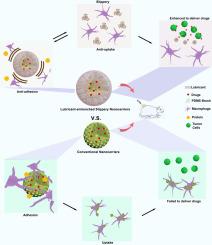Journal of Advanced Research ( IF 10.7 ) Pub Date : 2022-08-28 , DOI: 10.1016/j.jare.2022.08.015 Chengduan Yang 1 , Jianming Feng 2 , Ziqi Liu 2 , Juan Jiang 1 , Xiafeng Wang 1 , Cheng Yang 2 , Hui-Jiuan Chen 2 , Xi Xie 3 , Liru Shang 1 , Ji Wang 1 , Zhenwei Peng 1

|
Introduction
Reducing the protein adsorption of nanoparticles (NPs) as drug carriers to slow their rapid clearance by macrophages uptake is a critical challenge for NPs clinical translational applications. Despite extensive research efforts to inhibit cellular uptake, including covering biological agents or surface chemical coatings to impart “stealth” properties to NPs, their stability remains insufficient.
Objectives
Developed a novel surface modification technology based on a physical infusion engineering approach to achieve persistent inhibition of protein adhesion and cellular uptake by nanocarriers.
Methods
The nanoparticles were prepared based on conventional drug carrier mesoporous silica NPs through a two-step process. A functional nanoscale slippery surface was formed by grafting “liquid-like” brushes on the particles surface, and then a lubricant-entrenched slippery surfaces (LESS) was formed by infusing silicone oil lubricant into the entire surface. Co-incubation with macrophages (in vitro and in vivo) was used to examine the anti-uptake properties of modified NPs. The anti-adhesion properties of LESS coating surfaces to various liquids, proteins and cells were used to analyze the anti-uptake mechanism. Loaded with drugs, combined with tumor models, to evaluate the drug utilization of modified NPs.
Results
Relying on the stable and slippery LESS coating, the modified surface could prevent the adhesion of various liquids and effectively shield against the adhesion of proteins and cells, as well as remarkably reduce macrophage cellular uptake in vitro and in vivo. In addition, the LESS coating does not affect cell activity and allows NPs to be loaded with drugs, significantly improving the utilization of drugs in vitro and in vivo. This allows the NPs to reach to the target tumor site for drug delivery without active clearance by macrophages.
Conclusion
Our research introduces a new nanocarrier technology to improve anti-biofouling performance and stealth efficiency that will facilitate the development of nanomedicines for clinical transformation applications.
中文翻译:

基于润滑剂的光滑表面纳米载体可避免巨噬细胞摄取并提高药物利用率
介绍
减少作为药物载体的纳米粒子 (NPs) 的蛋白质吸附以减缓其被巨噬细胞摄取的快速清除是 NPs 临床转化应用的关键挑战。尽管为抑制细胞摄取做出了广泛的研究努力,包括覆盖生物制剂或表面化学涂层以赋予 NP 以“隐形”特性,但它们的稳定性仍然不足。
目标
开发了一种基于物理输注工程方法的新型表面修饰技术,以实现纳米载体对蛋白质粘附和细胞摄取的持久抑制。
方法
纳米颗粒是基于传统的药物载体介孔二氧化硅 NPs 通过两步法制备的。通过在颗粒表面接枝“液体状”刷子形成功能性纳米级滑面,然后通过将硅油润滑剂注入整个表面形成润滑剂浸润的滑面(LESS)。与巨噬细胞共孵育(体外和体内)用于检查修饰的 NP 的抗摄取特性。LESS涂层表面对各种液体、蛋白质和细胞的抗粘附特性被用来分析抗摄取机制。载药,结合肿瘤模型,评估修饰NPs的药物利用率。
结果
依靠稳定光滑的LESS涂层,修饰后的表面可以防止各种液体的粘附,有效屏蔽蛋白质和细胞的粘附,并显着减少体内外巨噬细胞的摄取。此外,LESS涂层不影响细胞活性,允许NPs负载药物,显着提高药物在体外和体内的利用率。这允许 NPs 到达目标肿瘤部位进行药物输送,而无需巨噬细胞主动清除。
结论
我们的研究引入了一种新的纳米载体技术来提高抗生物污染性能和隐身效率,这将促进纳米药物的临床转化应用的开发。


























 京公网安备 11010802027423号
京公网安备 11010802027423号